Examining ratings of junior players
If you follow chess events all over the world you will often come across players who perform better than their Elo ratings would suggest. Some players indeed appear to be significantly underrated, and how underrated they are often seems to depend on the country they are coming from. This has a number of reasons.
Impact of the lowered-rating floor
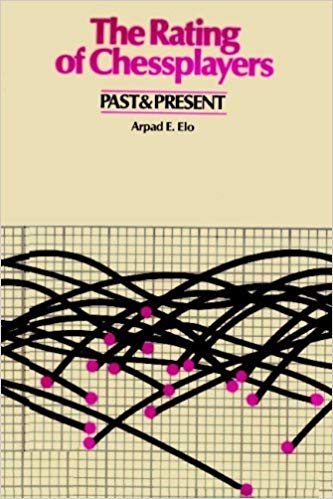 In this article I take a look at the impact of the lowered rating-floor (the minimum Elo rating) on Elo ratings in general. This is a topic that usually does not catch much attention even though lowering the rating-floor significantly increases the number of young players with an Elo rating. However, the Elo system does not really seem to be fit to deal with this phenomenon and the question arises whether the rules of calculating the Elo ratings really reflect the playing strength of young players adequately.
In this article I take a look at the impact of the lowered rating-floor (the minimum Elo rating) on Elo ratings in general. This is a topic that usually does not catch much attention even though lowering the rating-floor significantly increases the number of young players with an Elo rating. However, the Elo system does not really seem to be fit to deal with this phenomenon and the question arises whether the rules of calculating the Elo ratings really reflect the playing strength of young players adequately.
The numbers in this article are based on the players files in the FIDE archives that go back to 2001. The data for the time before 2001 is taken from the website OlympBase. The statistics are always based on the January lists.
The numbers given below distinguish between active and inactive players. If a player has not played any rated games for the previous twelve months he is considered to be inactive. If the status is not specifically mentioned below the player is an active player.
The development of the Elo ratings since 1970
FIDE adapted the Elo system in 1970 but it took until 1986 before 5000 players had an Elo rating. Now, the age pyramid of players with an Elo rating grows all over the world.
Table 1: Average values of players with an active Elo rating (January 2019)

In January 2019 India had 82,000 AICF-registered players, 40,514 of them were juniors. In Russia, too, more than half of the active players with an Elo rating are juniors. As far as tournament chess is concerned the USA and China seem to move a bit outside of the Elo system. The US Chess Federation (USCF) has 90,000 members but only 2,500 active players with an Elo rating. England also has a surprisingly low number of players with an Elo rating. Germany has the most active seniors (60+): 3229 seniors have an Elo rating and are active! Together with the inactive players Germany has 25,160 players with an Elo rating, and the average Elo rating of these players is 1882, almost a 100 points more than the average level of the "DWZ" of these players — the "Deutsche Wertungszahl", the national rating of Germany. Spain is the country that has the most players with an Elo rating. However, if you also take the inactive players into account Russia is clear first: 32,730 players in Russia have an Elo rating, and a lot of them are juniors.
The period since Elo ratings were introduced in 1970 can be divided into two phases:
In the first phase from 1970 to about 2000, more and more players had an Elo rating and there was a strong rise in Elo ratings. Among the top 1000 players this rise continued until 2012. It is difficult to say exactly what caused this ratings rise but it is obvious that we have more strong grandmasters today than we had in 1980 (see e.g. countries such as France or China). In 1990 there were no Chinese players in the top 100, today the average rating of the top 100 in January 2019 would drop from 2703 to 2696 if one ignored all Chinese players.
The second phase is marked by lowering the rating floor (minimum Elo) which led to a strong increase of the number of players with an Elo rating, most of them juniors. The Elo ratings of the top 1000 have been rather stable in this time but lower down, the level sinks a trend almost unnoticed by the public. Maybe the focus is too much on the top 100 and the number of GMs and IMs which continues to grow:
Table 2: Statistics of all GMs and IMs since 1985 (active and inactive)

The strong increase of titled players is probably a result of the strong increase of players who have an Elo rating and the fact that there are more tournaments in which you can get title-norms.
So, how about the ratings on the lower Elo levels?
Table 3: Average rating of active players
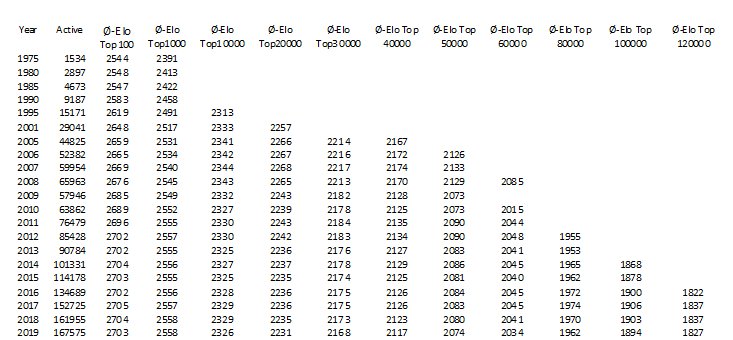
During the last seven years the top 1000 have established themselves on a high level. But in the top 20,000 to 40,000 the Elo ratings decrease on average, despite the strong overall increase of players with an Elo rating!
Table 4: Number of active players in rating groups
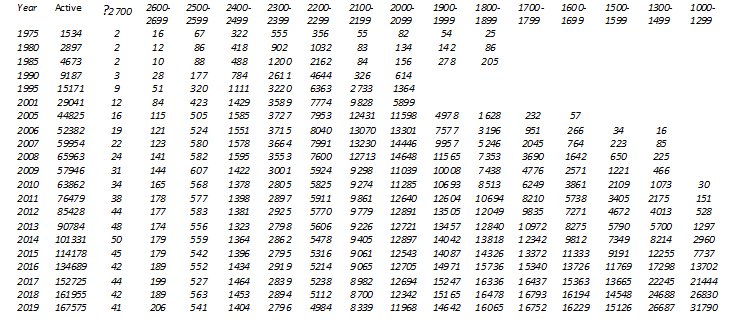
The number of active players who have an Elo rating between 2000 and 2400 also goes down. This is due to the fact that a lot of players in this rating range are listed as inactive and do not appear on this list. All in all about 160,000 players were listed as inactive in 2019, and about 60,000 of these players have not played a rated game in the last five years. In fact, a lot of these players have an Elo rating that has not changed for 10 or 20 years. Many of these inactive players have an Elo rating of more than 2000 because that was the rating-floor when these players were active. But the crucial question is: why do younger players not make up for this lower number of players with a rating between 2000 and 2400 though the total number of active players with an Elo rating has tripled during the last ten years?
In the next two tables the players who have been leaving or entering the rating-pool since February 2012 are not shown in the statistics. Tables 5 and 6 only include those active players from January 2012 who still can be found in the 2019 players list. Whether these players are active or inactive in 2019 is irrelevant. But it is important to understand that the players shown in 2012 in tables 5 and 6 are the same players as in 2019.
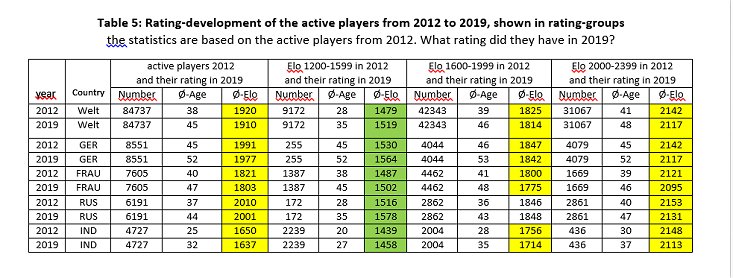

You may ask where the balancing influence of K=40 can be seen? Tables 5 and 6 do not show a closed system. The players who have been entering the rating-pool since February 2012 are not in the statistics, but they are influencing the Elo-ratings as some of them have been opponents of the players shown in table 5 and 6.
It can be seen that the youth of course increases their Elo level, but the overall level is slightly declining. The players from India over 20 years have a significant drop in the average rating, though these players are actually in the best chess age. The following chapter tries to explain this rating-decrease as a result of the age structure and of a fast growing amount of rated players in the India Chess Federation.
Lowering the rating-floor to 1000

Note: In 1987 the rating-floor for women was raised from 1800 to 2005
The rating floor (the minimum Elo) was first 2200 but since then has been lowered. This led to more and more junior players with an Elo-rating. Previously players maybe got an Elo rating when they were 20 years old, now they do get an Elo rating when they are 12 years old or even younger.
One may safely assume that every tournament that a junior player plays helps to increase his playing strength. However, the overall level of the young players remains the same after a junior tournament because they all have the same K-factor. But this is an inadequate reflection of their real playing strength.
Players develop particularly rapidly between the age of 10 to 18 but in these years you now only gain Elo points from other players (unlike previously). Some of these rating points come from junior players who quit chess. However, because the playing strength of virtually all junior players increases from the age of 10 to the age of 18 years these junior players mainly gain rating points from adult opponents who "sponsor" the ratings of the juniors. As a result a lot of players ranging from 1000 to 2000 Elo points are underrated which also affected higher Elo levels.
In 2014 the K-factor for juniors was raised to 40. If a junior player (K=40) wins against an adult (K=20) the number of rating points the junior gains is twice as high as the number of rating points the adult loses. The junior player reaches the rating that expresses his playing strength adequately faster but the overall level of the Elo ratings also rises.
Today's K=40 has the greatest impact when junior players play often against adults because they can show that their playing strength is not much ahead of their rating. But K=40 does not fully compensate the lowering impact the juniors have on the rating of the established players because the juniors gain rating points from players whose playing strength is adequately reflected in their Elo rating and who thus cannot fulfil their Elo expectation against underrated players. How junior players who lose Elo points and quit chess affect the ratings is still unclear.
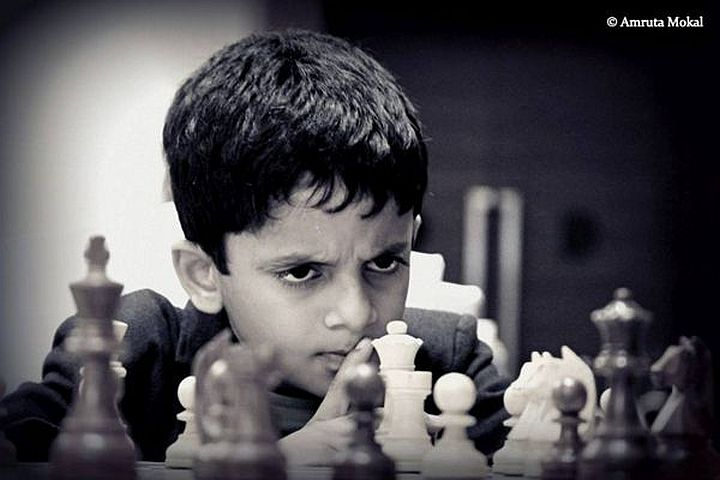
Nihal is one junior player who's not likely to quit | Photo: Amruta Mokal
Arpad Elo (1903-1992) already mentioned the deflationary impact of junior players on the Elo ratings. But if you look at the impact a single game has on the rating of an adult who loses against a junior you see that only a part of the rating loss of the adult is undeserved — depending on how much the junior player is underrated. To illustrate this phenomenon Berthold Plischke gave me the following example:
Junior J (Elo 1600) wins against adult A (also 1600). J wins 40*(1-0.5) = 20 points, A loses 20*(0-0.5) = -10. However, the 10 points A loses are not all undeserved losses: let's say J had a playing strength of 1700. Then A should have lost 20*(0 - 0.36) = - 7.2. Therefore he only lost about 3 points undeservedly.
In the last two years the Indian Chess Federation had 30% more members! Presumably, most of the new members were juniors. Thus the Indian Chess Federation has a lot of junior players who have only few contacts to players from abroad. As a result the percentage of games in which a junior plays against another junior rises while the percentage of games in which a junior plays against an adult goes down. However, the level of the ratings can only change when players with a different K-factor play against each other. In view of the many Indian junior players the Elo level of Indian juniors will probably rise slower than in Germany.
Germany once also had a large increase of the number of junior players. From 1951-1991 the German Chess Federation increased the number of their members from 25,000 to 90,000. But back then the Elo rating was not introduced or the rating floor was too high for most juniors.
Let's assume the following: if 100 players who are 30 years old and have an Elo average of 1800 only play against each other in the ten years to come what Elo level will these players have on average when they are 40? And then you take 100 10-year-olds with an Elo average of 1100 and for the next ten years they play only against each other — what an Elo level will they have when they are 20?
Proposals to calculate the Elo rating
Thanks to Berthold Plischke, responsible for controlling the "DWZ ratings" (the German ratings), and an expert in the field. When calculating the "DWZ", junior players have certain privileges until they are 25 and thus are better integrated into the rating pool. At the age of 25 you should be close to the playing strength you can reach. In 2016, the German Chess Federation introduced another rule to fight the phenomenon of underrated players: if the tournament performance of a player is at least 300 points better than his current DWZ his tournament performance — and not his current DWZ rating — is taken to calculate the new DWZ rating of his opponents.
Measures to raise the Elo ratings
In 1987, FIDE raised the Elo ratings of all women players (apart from Susan Polgar) by 100 points. One should consider whether to do something similar in countries in which the players are said to be underrated. However, such an increase of Elo ratings should be limited to lower ratings and should be implemented by degrees.
Thus, the German Chess Federation considers whether to increase the first DWZ rating of beginners that might be too low to numbers that are a bit below 1000. This would accept that these players might be overrated but it will be good for their future opponents.
Such an increase of the first Elo rating might also be a suitable solution for a country such as India to counter the phenomenon of underrated players.
The K-factor for junior players
To better account for the increasing playing strength of young players one could slightly raise the K-factor of the winner and slightly lower the K-factor of the loser in a game between two juniors. The winner then would gain more rating than the loser would lose.
A similar plus is necessary when adults play against juniors because the overall Elo level of junior players can only rise in games against adults.
Examples:
Now: Junior (K=40) against adult (K=20)
New: Junior (K=35) against adult (K=18 in case of a loss, K=20 in case of a draw, K=22 in case of a win)
Junior against junior (K=32 in case of a loss, K=35 in case of a draw, K=38 in case of a win)
These are randomly chosen K-values that just show the principle. This rule should also be limited to juniors with Elo<2300. But it is first of all important to do something against the deflation even if this means to adjust the K-factor every year anew.
Summary
More and more players have obtained Elo ratings since the Elo system was implemented in 1970. The low number of players with an Elo rating in the US and in China indicates that there will be even more players with an Elo rating.
Lowering the minimum Elo to 1000 led to a steady stream of low-rated players who joined the rating-pool. The large number of these players is enough to impact the ratings of established players and to lower their ratings. Table 4 shows this dynamic.
Changing the rules to allow juniors to increase their rating level even if they play in junior tournaments could reduce the pressure lasting on the established players.
Links
.jpeg)

















 In this article I take a look at the impact of the lowered rating-floor (the minimum Elo rating) on Elo ratings in general. This is a topic that usually does not catch much attention even though lowering the rating-floor significantly increases the number of young players with an Elo rating. However, the Elo system does not really seem to be fit to deal with this phenomenon and the question arises whether the rules of calculating the Elo ratings really reflect the playing strength of young players adequately.
In this article I take a look at the impact of the lowered rating-floor (the minimum Elo rating) on Elo ratings in general. This is a topic that usually does not catch much attention even though lowering the rating-floor significantly increases the number of young players with an Elo rating. However, the Elo system does not really seem to be fit to deal with this phenomenon and the question arises whether the rules of calculating the Elo ratings really reflect the playing strength of young players adequately.












